|
Seven:
Dealer's Choice
The
lack of a balanced economic
growth policy in Ottawa
has aggravated regional
alienation at a time when
Canada’s national unity
is under severe strain for
constitutional reasons.
This chapter is accordingly
about national unity from
a less-commonly heard perspective:
that of our regions and
our development policies
which have a negative impact
on national cohesion in
Outer Canada. An urgent
priority in Ottawa should
be to reverse present federal
government trends which
seem designed to reinforce
the hinterland status of
Outer Canadians.
Outer
Canadians are well aware
of the harm done to our
districts, towns and cities
by many Ottawa policies
and by Ottawa indifference.
For example, we are aware
that numerous federal initiatives,
including departmental and
Crown corporation procurements,
have encouraged considerable
overcrowding especially
since 1985 within viewing
distance of Toronto’s CN
Tower. The results have
included traffic congestion,
skyrocketing home prices
and rents, increased air
pollution, crime, irritability
and skill shortages. Many
parts of Outer Canada have
experienced chronic high
unemployment and out-migration
during the same period.
Quite understandably, Metropolitan
Toronto became the goal
of many of those hurt by
these circumstances and
looking for a job.
Few
Outer Canadians think Ottawa’s
exorbitant interest rates
and expensive Canadian dollar
are motivated by real concern
for our problems. When the
Governor of the Bank of
Canada and the Finance Minister
Stolidly defend an interest
rate level five percentage
points above that in the
United States, they maintain
it is indispensable to combat
inflation. In reality, they
are alarmed by price-hikes
in Toronto. They should
recognize that Ottawa’s
procurement practices, its
research funding and many
other of its policies are
aggravating the trend. Yet,
Michael Wilson implies that
increasing bankruptcies
across Canada are necessary
to wring inflation out of
the economy -- as if they
contribute to it significantly.
High
interest rates cannot effectively
fight inflation without
first bringing on a serious
recession. Speaking to several
groups of students and business
people this year in Edmonton,
I couldn’t find a single
individual who thought otherwise.
We Outer Canadians know
from past experience that
the recession John Crow
and Michael Wilson are creating
with corrosive interest
rates will have the most
serious and lasting impact
on the outer eight provinces
and the North. We also know
that a major reason for
the present interest rate
level is an attempt to keep
the Canadian dollar at a
level acceptable to foreign
holders of Canadian government
bonds, mostly Japanese and
American institutional investors.
Job
creation across the country
remains in large measure
a function of federal government
spending activities and
legislation. A more inclusive
national vision would pursue
balanced economic, social
and cultural growth as a
major national goal. This
would have important short
and long term positive effects
on the regions.
In
a host of ways, successive
national governments have
perpetuated economic disparities,
uneven growth and unequal
career opportunities for
Canadians on the basis of
their province of residence.
The 1879 National Policy
of John A. Macdonald planted
manufacturing firmly in
the core of Ontario and Québec. Subsequently, Ottawa’s
transportation, banking,
communications and other
policies enhanced the dominant
roles of Toronto and Montréal.
The AutoPact provided an
enormous stimulant to a
manufacturing sector located
almost exclusively within
southern Ontario and metropolitan Québec. The National Energy
Program of 1980 was intended
to weaken western private
and provincial government
dominance over one of the
few sectors that were not
yet dominated by Inner Canadians.
Regional
differences are key facts
of Canadian federalism.
It is federalism that ensures
that our diversity can be
maintained in Québec, as
well as in nine other provinces
and two territories. As
disparities among various
provinces persist and grow,
a number of economists and
political scientists have
become concerned, however,
with the question of "who
gets what" and "whom does
the political system serve."
The
benefits of any federal
union are much more subtle
and intangible than can
be represented by any arithmetic
on dollars won or lost.
The advantage of belonging
to a much envied country,
which unites French and
English or Atlantic and
Western Canadians, should
never be translated into
money alone. Equally, no
price tag or penalty should
be placed on one’s loyalty
to a province or region.
Much of the time, the evaluation
of benefits and costs of
Confederation to a region
or province is a matter
of opinion. perception and
evaluation in the eyes of
the beholder. The perceived
distribution of benefits
might have little to do
with dollar transfers or
material gains, but, more
importantly, be seen in
the sphere of attitudes
and subjective or symbolic
injustices. The long-held
Outer Canadian symbol of
the milk cow of Confederation
-- with its head grazing
in the pastures of the West,
its teats being milked in
Central Canada, and the
hind end dumping on the
Maritimes -- originates
from a subjectively perceived
popular analysis of the
benefits and costs of Confederation.
In large part, these perceptions
are based on economic matters
and the feelings of under-representation
for residents of most provinces
in national decision-making.
John
Hotson, executive director
of the Committee for Economic
and Monetary Reform, offers
this metaphor to characterize
the Canadian economy: "Canada
is like a ten-room house
with one hot room and nine
cold ones. People are crowding
into the hot room where
they can find a job, but
not a place to live, causing
real estate prices to explode."
Residents of the "cold rooms"
are likely to agree with
Hotson when he says that
more imaginative and fairer
national policies would
spread the heat so that
more Canadians could find
jobs from Newfoundland to
Vancouver Island.
According
to some preliminary Statistics
Canada data on provincial
economic performance released
in mid-1990, Ontario and
Québec accounted for almost
two-thirds of Canada’s gross
domestic product at market
prices in 1989 (Fig. 5).
Although British Columbia
had the highest growth rate
in the country during 1989,
it did not alter the basic
trend of the l980s -- the
continuing dominance of
Central Canada in the national
economy. It was beyond any
doubt another decade for
Inner Canada.
How
the Provinces Performed
1989
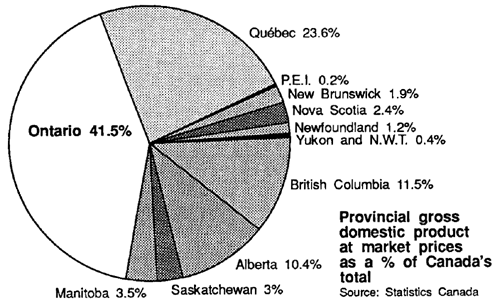
Figure
5
Other
national governments have
been much more successful
in stimulating balanced
economic growth. Within
the United States, Florida
led all fifty states in
growth during 1989. Orlando,
in central Florida, with
approximately a million
residents, ranked fourth
nationally during the same
year in attracting new business
facilities and expansions
of existing ones. The top
five metropolitan areas
in new plants and expansions
--Dallas, Portland, Atlanta,
Orlando and Los Angeles
-- are located in five different
American states. The best-performing
ten states under the same
criteria were Florida, California,
Alabama, North Carolina,
Texas, Ohio, Pennsylvania,
New York, Virginia and Georgia.
Not all regions are represented
in this group, but balanced
regional growth clearly
means far more in the United
States than in Canada.
Australia,
a vast land, sparsely settled
with just over 15 million
inhabitants, is often portrayed
as a "region-less" nation.
From data assembled by the
Australian Bureau of Industry
Economics in the early 1980s,
it is evident that disparities
in unemployment by state
and regional income differentials
in Australia were smaller
than in the United Kingdom,
Canada or the United States.
Regional problems certainly
exist in Australia and policies
designed to divert population
and economic activity away
from the major centres have
not worked as expected.
Nonetheless, regional fairness
is constantly on the agenda
of Australian cabinets.
In
Australia, the national
government has major fiscal
functions such as revenue
raising, but state governments
do undertake much of the
spending. As with Canadian
provinces, they exercise
a wide range of powers affecting
economic activity.
Section
99 of the Australian constitution
orders the federal government
to favour no state, or any
part of one, over another
state or its components.
Another section bars favouritism
on tax matters either between
states or within regions
of them.
After
World War II, tax concessions
were offered to the Australian
mining industry, which benefits
non-metropolitan areas.
Concessions similarly were
extended to petroleum exploration
and development companies
which had a positive impact
on remote areas such as
northwestern Australia.
Personal income tax concessions
are also available for inhabitants
of remote regions. These
areas have received special
assistance when their industries
have encountered difficulties.
Various forms of aid are
regularly offered to primary
industries in rural areas
for product research and
development, restructuring
and marketing. Finally,
special projects play arole
in decentralizing policies:
irrigation schemes, railway
and wood construction, the
placement of military and
educational institutions,
and the development of the
national capital, Canberra,
away from metropolitan Australia.
In
Japan during the 1989-90
fiscal year, the national
government allocated 300
billion yen for grants known
as the "furusatososei,"
or creation of home towns,
to revitalize regional economies.
Three thousand cities, towns
and villages, including
a tiny island village 367
kilometres off the coast
of Tokyo with only 210 residents,
will receive a special grant
from the government up to
an amount of one hundred
million yen (approximately
$900,000 Can.). Such communities
will spend it to attract
young people to "come home."
The Japanese ministry responsible
for carrying out this project,
while conceding that 100
million yen will not be
enough to revitalize all
regions, stresses that the
real objective of the project
is to get people thinking
about how to revitalize
their towns and regional
economies. Political scientists
in Japan say the "furusato
program" will have a
positive effect in boosting
morale in many regional
communities across Japan
by sending a message that
the government is henceforth
watching Out for "country
folk." In Canada, efforts
to create such a "caring
image" in the regions have
rarely been a priority of
our national governments.
Is
it any wonder that the perception
of Ottawa indifference and
remoteness persists among
Outer Canadians? The government’s
tendency to abandon the
regions is contrary to the
spirit of the Japanese "furusato
program." Instead of attracting
people and keeping them
employed in small communities,
it favours the already overpopulated
metropolitan centres and
lets the small communities
die.
From
Ottawa’s Department of Regional
and Industrial Expansion (DRIE) figures for 1986-87
and 1987-88, it is obvious
that our largest, most diversified
and industrialized provinces,
Québec and Ontario, received
the major portion of regional
grants: 60 per cent of the
total in 1986-87 for both
of the provinces, and 71.5
per cent during 1987-88.
A closer look at regional
development funds reveals
astonishingly that they
tend to benefit major urban centres, not small remote
and underdeveloped communities
as anyone would expect.
"For one thing, they appear
to have ended up favouring
the major urban centres
where much of the development
would probably have occurred
in any case; for another,
it was costly," said the
1989 Report by Canada Employment
and Immigration’s Advisory
Council.
In
May, 1990, the Mulroney
government announced with
much fanfare that $584 million
spread over five years would
be spent to revive the fishery,
diversify the Atlantic economy
and create more employment
in the troubled Atlantic
region. Whether the program,
still short on details,
is going to accomplish all
these goals in four severely
depressed provinces, the
amount of the package was
low relative to federal
regional development funds
going to Québec and Ontario,
our two provinces with the
most diversified economies.
For example, during 1988-89
alone, these two large provinces
received fully $633.9 million
in grants and contributions
from DRIE, now "the lead
department for regional
economic development in
Ontario and Québec," in
the wording of the 1988-89
annual report of DRIE and
the new Department of Industry,
Science and Technology.
Economic
development in the West
and Atlantic Canada is in
future to be the sole responsibility
of the Western Diversification
Department, with a budget
of $1.2 billion spread over
seven years, and the Atlantic
Canada Opportunities Agency,
with $1.05 billion
spread over seven years.
Their budgets, though considerable
and much needed in both
regions of Outer Canada,
do not compare favourably
with the financial help
Ottawa provides each year
to Ontario and Québec filtered
through a host of different
programs, departments and
subsidiaries. In fact, these
funds, including the half
a billion dollars provided
for Atlantic programs over
five years, contrast with
the $1.3 billion the Etobicoke
North riding in the greater
Toronto area received in
contracts awarded by the
federal Supply and Services
Department during 1987 alone.
If the eight outer provinces
received a fair share of
the goods and services bought
each year by the federal
departments and Ottawa’s
crown corporations, special
economic development programs
would be unnecessary.
In
their editorial comments
on the government’s aid
program for Atlantic Canadians,
two Inner Canada newspapers,
in effect, invited Ottawa
policy makers to treat them
as fodder for Toronto’s
labour market. The Ottawa
Sun considered that
"a good many more Maritimers
and Newfoundlanders should
be thinking of relocating
in Central Canada where,
right now, there’s a shortage
of labour." In like manner,
The Globe and Mail observed:
"The government cannot continue
to support indefinitely
Canadians in communities
with little hope of employment."
Both newspapers would apparently
prefer every Atlantic Canadian
to resettle in the Toronto
area. Do they really want
twenty-six million Canadians
to live in Metropolitan
Toronto?
While
national governments in
other countries attempt
to spread economic activity
more evenly, Outer Canadians
see the historic pattern
of power and wealth concentration
in Central Canada flourish.
Personal income per resident
for Canada as a whole averaged
about $18,070 in 1987, for
example, but it was only
$12,400 in Newfoundland
(Fig. 6). The highest provincial
income in the land was not
far off twice the lowest.
Personal
Income Per Capita by Province
1987
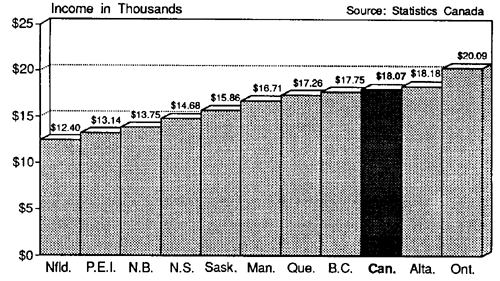
Figure
6
Across
Canada, during 1989 and
into 1990, there were 144
businesses started which
already employ more than
fifty individuals. Eighty-five
of them -- sixty per cent
-- are located in Ontario
and Québec; 52 are in Western
Canada; only seven are in
the four Atlantic provinces.
None is in the North. According
to the Financial Post’s
1989 ranking by sales or
operating revenues, 365
of our largest 500 companies
-- 73 per cent --have their
head offices in Ontario
or Québec (Fig. 7). An even
greater percentage of the
largest financial institutions
-- four-fifths -- are based
in Ontario and Québec, leaving
eighteen percent for the
West and a pitiful two per
cent for Atlantic Canada.
Toronto itself houses the
head offices of forty-five
of our large financial businesses,
with nineteen in Montréal,
three in Québec City, seven
in Vancouver and two in
Edmonton. The head offices
of all six of the major
chartered banks are located
in Toronto or Montréal.
Such head office concentration
might be understandable
for London or Paris in the
case of relatively small
Britain or France. In the
United States it does not
exist to nearly the same
extent.
Head
Offices of Top 500 Companies
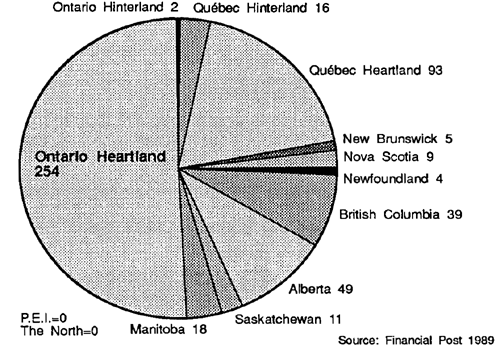
Figure
7
A
strong argument can be made
that our private sector
must be free to locate corporate
and head offices where it
chooses and to expand where
it is most cost efficient
to do so. On the other hand,
when Northern Telecom expanded
to the United States its
senior management was told
informally that to be considered
a responsible national company
it must locate manufacturing
facilities in different
regions of the country.
Northern Telecom complied,
building its American manufacturing
facilities in five regions.
To its credit, it has done
so in Canada as well. American-based
companies, involved in manufacturing
in various parts of the
United States as responsible
corporate citizens at home,
should spread their Canadian
subsidiaries across Canada,
instead of concentrating
them in Canada’s Main Street.
During
1988, of the fifty fastest
growing Canadian companies,
two-thirds were Ontario
or Québec companies. Only
fifteen were in the West
and only two called an Atlantic
province home. Even more
significant perhaps are
the figures for the so-called
companies of tomorrow. They
include the up and coming
along with some which have
slipped out of the 500 largest,
such as B.G. Checo International
of Montréal, dealing in
electronics, and Simplot
Canada of Brandon, a fertilizer
company. Only three per
cent of these businesses
now have their head offices
in Atlantic Canada, twenty-four
per cent in the West, and
seventy-three per cent are
in Ontario or Québec (Fig.
8).
"100
Companies of Tomorrow"-Head
Offices
By Region
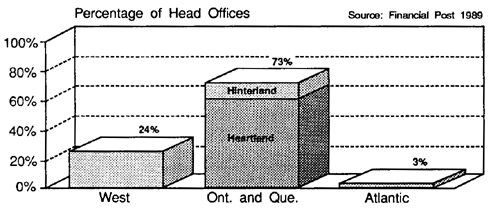
Figure
8
Despite
some deficit reducing measures
undertaken by the Mulroney
government, Ottawa handouts
to large businesses continue.
Hundreds of private-sector
companies, some very prosperous,
receive billions in taxpayers’
money each year as unnecessary
subsidies. It is estimated
that Ottawa today spends
$8 billion annually on subsidies
to promote exports, industrial
expansion, research and
development and related
activities. This figure
does not include a host
of very large federal tax
breaks and loan guarantees.
For example, among eight
companies from the 1988
list of beneficiaries, seven
were headquartered in Ontario
or Québec and one in Calgary.
One of them, Noranda, with
a net income of $603 million,
received approximately $22
million in grants from federal
taxpayers.
Between
September, 1984, when the
election of the first Mulroney
government was elected and
January of 1990, approximately
1.6 million jobs were created
across Canada, virtually
all by the private sector
(Fig. 9).
Job
Creation Statistics
Sept. 1984 to Jan. 1990
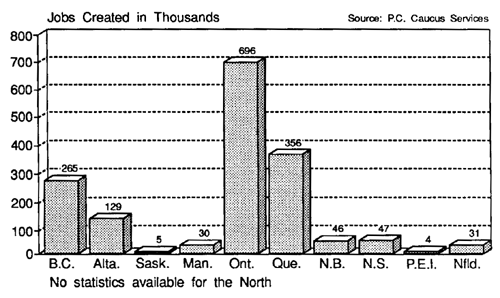
Figure
9
Approximately
8 per cent of the jobs created
were in Atlantic Canada,
24 per cent were in Western
Canada, and 65 per cent
were in Ontario and Québec.
As of December 1989, almost
80 per cent of the manufacturing
jobs were in Ontario and
Québec (Fig. 10). A common
excuse from manufacturers
in southern Ontario as to
why they do less and less
manufacturing in Outer Canada
is that it lacks population
from which employees might
be recruited. However, a
spokesman for one manufacturing
company told me recently
that they face on-going
difficulty in hiring enough
people for their three plants
located within Metropolitan
Toronto.
Manufacturing
Sector Employment
December 1989

Figure
10
Regional
Unemployment
The
opposite side of this coin
is the regional breakdown
of unemployment rates. The
Economic Council of Canada
noted in its 1977 study
of regional disparities
that "Unemployment in some
areas of Canada continues
to be a national disgrace."
Today, thirteen years later,
the situation has not improved
and in some locations has
actually grown worse (Fig.
11).
Unemployment
Rates
By Province
April 1990
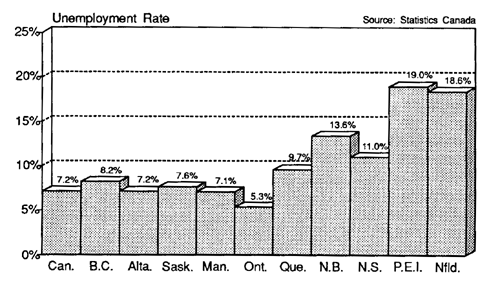
Figure
11
The
difference among regions
in unemployment rates of
as much as eighteen percentage
points shows that our recovery
since the 1981 recession
has been the most uneven
of modem times. For example,
in March 1990, the average
unemployment rate across
Canada was 7.2 per cent.
In the same month, the unemployment
rate in the Gaspé region
of Québec was 23.1 per cent;
in the Port-aux-Basques
area of Newfoundland, 21.3
per cent; and in the New
Brunswick counties of Northumberland,
Restigouche and Gloucester,
20.6 per cent, while in
the Toronto and Ottawa-Carleton
regions the rate was 4.8
per cent.
The
spring 1990 issue of Statistics
Canada’s Canadian Social
Trends carried an article
by David Gower, a Statistics
Canada analyst, on regional
unemployment in Canada.
He concluded his analysis
of the 1985-88 regional
unemployment rates by saying
that regional inequality
in unemployment is growing,
and the gap between the
areas of high and low rates
is widening. Statistics
Canada figures reveal that
almost all of our ten areas
with the highest unemployment
rates during 1988 were in
the Atlantic provinces and
peripheral parts of Québec.
Non-metropolitan Newfoundland
experienced the highest
unemployment rate of any
region in Canada in recent
years: 19.2 per cent during
1988. Two hinterland regions
in Québec, the Lower St.
Lawrence and Lac St-Jean-Cote Nord, had the second and
third highest unemployment
rates in the country during
1988 with 13.8 per cent
and 13.1 per cent respectively.
Gower
concludes that in general,
between 1985 and 1988, unemployment
rates decreased about forty
per cent in our ten highest
employment regions, compared
with a twenty per cent decline
in the high unemployment
ones. In the 1988 survey
of forty areas across Canada,
every one of the 10 areas
with lowest unemployment
rates came from Ontario
with nine of those ten in
southern Ontario.
As
the Economic Council of
Canada noted in its 1990
study of our national service
sector, Good Jobs, Bad
Jobs, "virtually all
recent employment growth
has involved either highly
skilled, well compensated
and secure jobs or unstable
and relatively poorly paid
jobs." By this, it meant
that a computer programmer
in a head office has a good
service job and a bright
future whereas a postal
worker in a Newfoundland
outpost has a meagre income
and doubtful prospects.
The growing division of
service employment across
Canada into "good-job" and
"bad-job" sectors during
the 1980s and 1990s will
increase disparities between
our regions because good
jobs tend to be concentrated
in large cities -- the dominant
centres of service growth
-- which are disproportionately
located in the more developed
communities within Ontario.
How
are Ottawa’s myriad agencies,
departments and crown corporations
doing in an age of instant
communications in providing
regional leadership to our
private sector? Only five
of forty of our largest
or best-known national crown
corporations have their
head offices outside Inner
Canada. Not one of the five
is in Atlantic Canada. The
five in Western and Northern
Canada are: Canadian Wheat
Board -- Winnipeg; Cameco
(formerly Eldorado Nuclear)
-- Saskatchewan; NWT Power
Commission -- Yellowknife; Petro-Canada -- Calgary;
and Canada Harbour Place
Corporation -- Vancouver.
The other thirty-five are
all located in either Ottawa
or Montréal. Some seem especially
out of place there given
the nature of their activities
and the locale of their
clientele. Why, for example,
do the St. Lawrence Seaway
Authority, Farm Credit Corporation,
Canada Ports Corporation,
and Canadian Dairy Commission
need to be in Ottawa-Hull?
Newcomers
In
the crucial area of immigration
as a stimulus to local economies,
congested Inner Canada continues
to be the disproportionately
dominant destination of
most newcomers to Canada.
There are also concerns
in Outer Canada that the
proposed Ottawa-Québec City
agreement on immigration
in the wake of the collapse
of the Meech Lake accord
will mean in practice that
Québec must receive twenty-five
to thirty per cent of all
future immigrants to maintain
its present share of our
population. This might well
translate into a reality
that nine other provinces
are held back in the numbers
of newcomers they can have
in order to maintain this
population ratio if Québec
has difficulty in attracting
its allotted share in a
given year.
Between
1946 and 1986, approximately
3.5 million immigrants arrived
in Canada. Nearly two million
of them settled in Ontario.
During 1988, the largest
share of all categories
of immigrants understandably
went to booming Ontario:
fifty-six per cent of the
family class, fifty-five
per cent of the independents,
and fifty-four per cent
of refugees and designated
classes of newcomers. In
the same year, 83,000 persons,
or fifty-two per cent of
the total number of immigrants,
settled in three cities:
Toronto, Montréal and Ottawa-Hull.
During
1988, approximately 4,000
business immigrants arrived
in Canada (Fig. 12), with
two-thirds going to Ontario
and Québec, eight per cent
to the Prairies, twenty-five
per cent to British Columbia
and the Yukon, and only
two per cent locating in
Atlantic Canada. It is estimated
that entrepreneurs and self-employed
individuals arriving during
that year brought with them
approximately $3.4 billion
available for investment.
Ontario and Québec received
about half of this total.
In Outer Canada, in fairness,
British Columbia benefited
from about $1.3 billion
in new investments from
immigrants.
Destinations
of Business Immigrants
1988
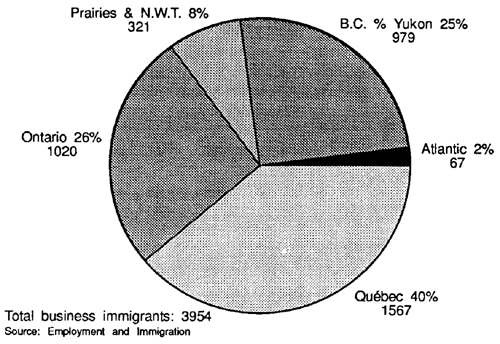
Figure
12
The
"investor" group of immigration
categories, which allows
in people with $250,000
or more in cash, does not
require that the investors
live in the same province
as their investment. A recent
policy change authorizes
such newcomers to invest
$250,000 in Alberta, Saskatchewan,
Manitoba, the Yukon, the
Northwest Territories and
the Atlantic provinces.
Immigration policy-makers
in Ottawa are in short so
unfamiliar with business
opportunities across Outer
Canada that they actually
believe that the specified
areas could not attract
new investment if the amount
of $350,000 necessary for
Ontario, Québec and British
Columbia was maintained
for the "boondocks."
Ottawa
Spending
In
advanced industrial democracies,
government purchasing policy
has long been recognized
as an important instrument
of economic policy in advanced
industrial democracies.
In Canada, Ottawa’s regional
procurement favouritism
generates on-going federal-provincial
conflict. Outer Canada governments
claim with good reason that
federal purchasing policies
actively contribute to the
growing concentration of
industry in Ontario and Québec. "They are correct
said Donald Savoie, an authority
on regional development,
during 1986. "About eighty
percent of all federal contracts
are placed with firms in
Central Canada." Professor
Allan Tupper of the University
of Alberta, in his Public
Money in the Private Sector:
Industrial Assistance Policy
and Canadian Federalism,
wrote in 1982 that Ottawa’s
Department of Supply and
Services "seems rather resigned
to the continuing pre-eminence
of centrally-located firms"
and concluded "Ottawa does
not appear to have consistently
employed purchasing policy
as a regional development
tool." There seems to be
little sign of improvement
since that time.
Always
a factor in Canadian political
decisions, the "numbers
is politics" reasoning clearly
prevails in the present
pattern of Ottawa spending.
This is at any rate how
it is perceived by some
provincial governments.
They tend to interpret every
discrepancy in the allocation
of spending as Ottawa’s
regional bias. Frustrated
with their recent experience
in Confederation, they draw
balance sheets showing they
are losers in dealings with
the federal government.
If this federal government
were to adopt regional criteria
in allocating its overall
procurement of goods and
services, its large role
as employer and purchaser
would make it an efficient
instrument to achieve greater
regional fairness.
Government
facilities, varying from
armed forces bases to post
offices, are scattered across
the country. Where such
facilities are built, where
Ottawa turns for its supplies,
where it hires and employs
people, and where it establishes
and maintains defence bases
has important effects on
the regional distribution
of benefits. Its practices
here also create an impression
of regional fairness or
unfairness. During the fiscal
year 1987-88, total federal
government spending on goods
and services amounted to
$9.6 billion (Fig. 13a and
13b). By total tax dollars
spent, Québec and Ontario
received 51 per cent of
the government’s purchases.
The four western provinces
got 10.9 per cent. Atlantic
Canada’s total of 35.2 per
cent was much higher than
normal because of the award
of the patrol frigate contract
to the Saint John dockyard.
For the 1986-87 fiscal year,
the numbers were even more
distressing: Central Canada
--76 per cent, Western provinces
-- 11.5 per cent, and Atlantic
Canada -- 7 per cent.
Federal
Government Procurement
By Province
1987-1988

Figure
13A
Federal
Government Procurement
By Region
1988-1989
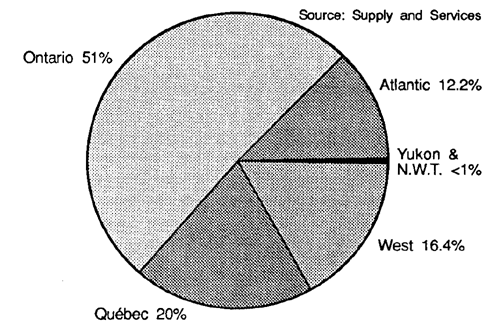
Figure
13B
Individual
federal government departments
and major federal crown
corporations often display
the same dreary pattern
as far as their expenditures
on goods and services are
concerned. The chart "Spending
on Goods and Services" graphically
shows the procurement practices
of some selected federal
government departments and
agencies (Fig. 14)
For
example, Ottawa’s Public
Works ministry bought $106
million in goods and services
in 1988-89. Eighty-three
percent was obtained through
its offices in Ontario and Québec. During the same
year, Labour Canada bought
an astonishing ninety-three
percent of its goods and
services within Ontario
and Québec, including the
National Capital Region.
The Canada Council, which
specifically denies any
role for regional justice
in its cultural mandate,
purchases less than one
per cent of goods and services
beyond Toronto-Ottawa-Montréal.
During 1988-89, the Ottawa-based
International Development
Research Centre placed orders
with suppliers in eighteen
different countries, including
Ethiopia, Botswana, Sri
Lanka and Panama. At home,
however, during the same
year a breathtaking ninety-nine
per cent of its orders were
awarded to suppliers in
Ontario and Québec.
Spending
on Goods and Services
1988-1989
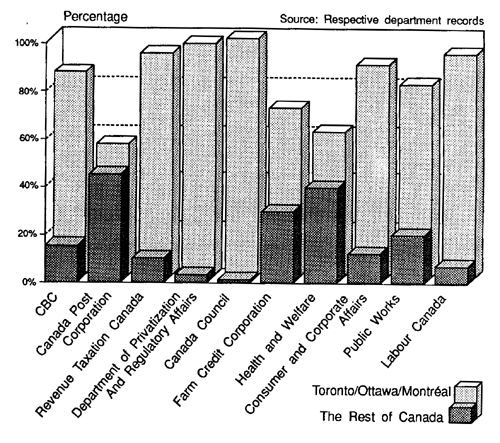
Figure
14
One
model of what national agencies
might be, a clear exception
to the norm, is the Federal
Business Development Bank (FBDB). Eighty-five per
cent of the FBDB regional
and branch office supply
expenses are made outside
of the Toronto-Ottawa-Montréal
triangle. It currently employs
1,250 persons across Canada:
fifty per cent of the total
number in Central Canada,
thirty-six per cent in the
West and fourteen per cent
in Atlantic Canada. On a
provincial basis, as of
March 1988, the FBDB’s loan
portfolio included over
7,400 customers in Central
Canada; 6,100 in Western
Canada and 2,175 in the
Atlantic provinces. This
is a federal agency attempting
to enfranchise every part
of the country.
Defence
Dollars
It
is occasionally argued that
defence spending should
not be considered a regional
development tool because
of efficiency and vaguely-defined
security considerations.
Other NATO countries, however,
have been more successful
in stimulating local economic
development in stagnant
areas through the awarding
of defence contracts and
the location of bases. In
Britain, where the southeast
is already overcrowded with
military research laboratories
and facilities, there is
growing pressure to move
such facilities and service
personnel to other regions
of the country. Michael Heseltine, a possible Conservative
successor to Margaret Thatcher,
in his book, The Challenge
of Europe, stresses
the need to give the whole
of the country a fair share
of wealth-creating potential.
Tim Sainsbury, the junior
British Defence Minister
responsible for procurement,
set out the Thatcher government’s
position when he announced
the transfer of 1,500 jobs
from London to Teesside,
in northeast England.
In
Canada, as past statistics
indicate and the April,
1989 federal budget reinforces,
the trend is to concentrate defence-related activities
within Inner Canada. A determined
federal government as the
principal customer for Canada’s
munitions industry could
have major influence on
where that industry is located.
Despite its dependence on
Ottawa for its so-called
modernization grants as
well, more than ninety per
cent of the 3,000 jobs in
that industry are within
Ontario and Québec. According
to Supply and Services unofficial
departmental statistics
for the period of April
1988 to February 1990, Central
Canada received ninety per
cent of the value of munitions
contracts awarded ($333
million) (Fig. 15). The
four western provinces received
only eight per cent of the
contracts, and the Atlantic
provinces 1.3 per cent.
Defence-generated
spending in the aircraft
and parts industry also
benefits Ontario and Québec
virtually exclusively. For
example, during the 1982-83
fiscal year, it provided
Ontario and Québec with
75 per cent of available
jobs. Offset contracts associated
with our two major aircraft
purchases, the CP-140 and
CF-l8, also go mostly to
Ontario and Québec.
Under
Ottawa’s Defence Industry
Productivity Program (DIPP),
which is designed to assist
high technology firms in
the defence sector, ninety
per cent of the payments
in dollar value went to
companies in Québec and
Ontario during the fiscal
year 1987-88. No-one in
PEI, New Brunswick, Saskatchewan,
Yukon or the NWT received
a thin dime of this tax-payer-funded
work. During the 1988-89
fiscal year, Québeckers
and Ontarians received ninety-five
per cent ($213.3 million)
of the money available in
the program. The four western
provinces got four per cent
and Atlantic Canada a mere
$400,000.
Munitions
Contracts
By Region
Apr. 17, 1988-Feb. 6, 1990

Figure
15
In
reply to my letter of inquiry
about the DIPP’s blatant
regional unfairness, H.G.
Rogers, the Deputy Minister
of Ottawa’s Department of
Industry, Science and Technology,
conceded in an early 1990
letter: "As you correctly
stated, the majority of
the money is spent in Québec
and Ontario ... DIPP assistance
is forthcoming in response
to industry investment intentions.
As most of the industry,
and hence most of the new
investment by industry is
located in Central Canada,
the majority of DIPP funds
are also expended there."
In other words, the ministry
provides no guidelines to
encourage using tax money
paid by all Canadians to
achieve even the tiniest
degree of regional fairness
on defence matters.
Even
the Toronto Globe and
Mail admitted editorially
that "DIPP is really another
regional development subsidy
spreading federal money
mostly in Québec and Ontario.
Almost all of these companies
can obtain financing through
normal commercial means."
Those receiving the funds
are well-known names in
Canada’s aerospace, defence
and high-technology industries,
such as Spar Aerospace Ltd.,
Canadian Marconi Ltd., CAE
Electronics Ltd. and Canadian
Astronautics Ltd., but also
privatized crown corporations
such as Canadair Ltd. in Montréal, now owned by Bombardier,
and De Havilland Aircraft
of Canada in Toronto, a
subsidiary today of Boeing.
Bombardier received a $43
million loan to develop
a regional passenger jet
and De Havilland, $50 million
to produce a series of its
Dash 8 commuter plane.
According
to the Statistical Abstract
of the United States 1989,
the American federal
government in contrast allocates
defence contracts in all
fifty states. These cover
military awards for supplies,
services and construction.
The total budget for 1987
was more than $131 billion.
Of this total, fifteen eastern
states received approximately
thirty-four per cent of
the contract funds; seventeen
western states received
approximately twenty-seven
per cent; and eighteen central
states received a third.
Seventy-two per cent of
the fifty states each received
over half a billion dollars
in defence contracts, and
fifty-four per cent of the
states received over a billion
dollars. The average appropriation
for defence contracts in
each state was $2.6 billion.
In short, elementary regional
justice was done for virtually
every corner of the country.
According to our own Department
of National Defence statistics
for the fiscal years 1985-86
and 1986-87, a breathtaking
seventy-seven per cent and
sixty-six per cent respectively
of the dollar values of
contracts were awarded in
the Montréal-Ottawa-Toronto
triangle. The department
says it did not keep records
of financial activities
by specific urban areas
before 1985.
Analysis
of the 1988 Public Accounts
list of contracts awarded
by DND by a specific area
of specialization shows
a less than equal distribution
of contracts in Canada’s
regions. In 1987, for defence
engineering services, Western
Canadians received only
eight per cent of the total
allotted budget amount.
In training and education,
the Atlantic provinces received
fourteen per cent of the
contract but only 8.6 per
cent of the funding by dollar
amounts. For computer services,
Central Canadians received
no less than ninety-seven
per cent of the budget.
For scientific services,
Central Canada received
96 per cent of the available
contract funds.
The
Department of National Defence
study on its estimated spending
in each federal constituency
for the fiscal year 1988-89
did it little good in parts
of Outer Canada. For its
regular military and civilian
staff then numbering 112,000
persons, only 8,400 were
based in the three poorest
provinces of Atlantic Canada.
The cutbacks announced since
then will reduce this number
even further. The "have-not"
Western provinces of Manitoba
and Saskatchewan together
included only 7,350 military
personnel among their residents
and these modest numbers
will also shrink with the
cutbacks at places like
Portage La Prairie. In terms
of defence spending on items
other than salaries, the
study is equally uninspiring
from the standpoint of the
hinterland. Atlantic Canada
that year received about
17.3 per cent or some $793
million of such spending,
but closer examination reveals
that two-thirds of it went
to Saint John for the frigate
contract. Toronto’s Etobicoke
North riding alone received
almost $500 million in the
same year. In the West,
Saskatchewan received a
pitiful $16 million.
Obviously,
such patterns can be reversed
only through a new and iron-willed
government direction. New
defence spending policies
which focus development
on our Western and Atlantic
provinces will not only
help their economies but
will also stimulate migration
to these areas, which in
turn will stimulate spin-off
economic activities. It
will also strengthen national
unity and the sense that
Ottawa is for once acting
like a national government.
As demonstrated in the United
States, government spending
can generate development
in isolated areas. It can
also promote a common national
direction and teamwork among
Canadians everywhere.
Research
and Development
Research
and development (R &
D) is usually defined as
creative work undertaken
on a systematic basis to
increase the level of scientific
and technical knowledge
and the use of this knowledge
in new applications. If,
on the world scene, Canada
in general and our outer
regions in particular do
not want to be again relegated
to roles as hewers of wood
and drawers of water in
the coming century, our
R & D activities need
to be assessed carefully.
Spending on R & D is
an important indicator of
the national effort to stimulate
creative activity, and is
directly linked to technological
innovation and economic
growth. As the federal government
is one of the major funders
of R & D in Canada,
the level and the distribution
of such expenditures shows
where Ottawa is concentrating
its development efforts.
Ottawa,
Toronto and Montréal are
the three major "nodes"
of science and technology
within Canada. For example,
more than 25,000 Ottawa-Hull
residents work in high-technology
firms or government labs.
A quarter of the 1987-88
federal budget for R &
D was spent in the National
Capital region alone. The
Western provinces received
twenty per cent of the $2.3
billion our federal government
spent on research and development
during 1987-88. Ontario
got a little more than half;
Québec approximately twenty
per cent; and Atlantic Canada,
eight per cent (Fig. 16).
The Mulroney government
is spending hundreds of
thousands of public dollars
to relocate the Space Agency
from Ottawa to a community
near Montréal, but declines
to spend a greater share
of Ottawa’s R & D money
across Outer Canada.
Spending
on Research and Development
Federal Government
1987-1988
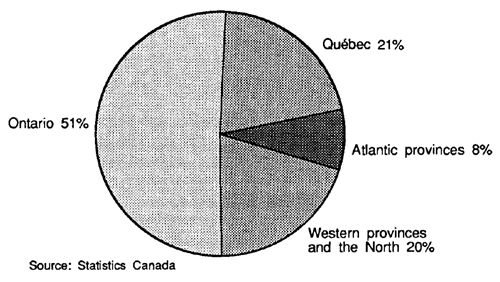
Figure
16
Much
of Central Canada’s dominance
in research and development
is because of the concentration
of federal government scientific
establishments in the region.
In this regard, the recent
decision by the Minister
of Energy, Mines and Resources,
Jake Epp, himself a Manitoban,
to close a federal surface
mining coal and oil sands
laboratory at Devon, Alberta,
the only such facility west
of Ontario, is the opposite
of regional justice, especially
when his department already
has three such labs in Ontario,
one in Cape Breton and one
more proposed for Québec.
Ottawa
Mandarins
"There
can be little doubt that
Canada has been dominated
economically since Confederation
by Ontario and Québec and
particularly by a relatively
small group of people and
companies located in Montréal
and Toronto," concluded
David Walker of the department
of geography, University
of Waterloo, when analyzing
Canadian regional development
policy in 1983.
A
continuing conviction shared
by Outer Canadians is that
we are chronically under-represented
in the public service of
our country. Atlantic Canadians
protested soon after Confederation
about this; francophones
have long complained that
they are under-represented
at more senior levels. Kenneth
Kernaghan concluded in a
1978 study that middle levels
of the pubic service were
more representative of the
country as a whole than
were senior ones in terms
of both birthplaces and
geographical regions.
Two
years later, Dominique Clift
wrote that a disproportionate
number of top officials
were from Ontario. The journalist
Jeffrey Simpson revealed
during 1981 only one deputy
minister and three of 198
assistant deputy ministers
were Albertans. Roger Gibbins
points out in his book,
Regionalism: Territorial
Politics in Canada and the
United States, that
as of 1982 provincial origin
was not, in the mind of
the Public Service Commission
of Canada, a factor at all
relevant to recruiting federal
officials. By my own inquiry
it has still not become
one.
Toronto,
Ottawa-Flu 11 and Montréal
together contain almost
half of the more than 200,000
federal employees. About
one third of federal government
employees live in the National
Capital Region. In the United
States, the equivalent figure
for Washington, D.C. is
only twelve per cent. The
new national Liberal Leader,
Jean Chrétien, revealed
during the early 1980s that
only one out of seven senior
executives in the federal
public service lived outside
Ottawa-Hull. Chrétien also
noted that as many as seventy
per cent of senior government
policy makers in Ottawa
had little or no regional
experience and that as many
as half of them never worked
outside Ottawa during their
entire careers. There appears
to be a clear consensus
now among federal mandarins
that there is no such thing
as a parallel career for
their colleagues "in the
regions." Job classifications,
salaries and a host of other
factors make it clear to
everyone that the best careers
are ones which begin and
end in Ottawa.
Data
on the regional or provincial
composition of federal officials
are difficult to find because,
unlike linguistic and gender
data, they are rarely recorded.
My own survey of the 220
most senior individuals
in twenty-eight federal
departments and agencies
in mid-1989 indicated that
only about ten per cent
were born and educated in
Western Canada. Four per
cent were from Atlantic
Canada in both education
and birth. Senior executives
who were both born in and
educated in either Ontario
or Québec hold seventy per
cent of the highest posts.
Eight per cent of the top
job holders were born outside
Canada, but all of them
had received at least part
of their education in Ontario
or Québec. None of these
high-achiever newcomers
to Canada had completed
any post-graduate education
outside Inner Canada. None
of the officials surveyed
was born or educated in
the Yukon or Northwest Territories.
The remainder were persons
born in Outer Canada who
later either moved to Ontario
or Québec or completed their
education there.
The
experience of a Manitoba-born
friend seems relevant here.
Applying in Winnipeg for
a professional position
in the public service several
years ago, she was shown
only a small number of those
available in her own province
even though she was willing
to relocate. She moved to
Ottawa and shortly afterwards
applied to the Public Service
Commission where the list
of available positions seemed
endless. She quickly had
an interesting position
in the capital. Is this
justice for all or only
for those who can afford
to move without first having
a job?
During
1989, there were eleven
senior executives in the
Prime Minister’s office
(PMO), influential advisers
in our system of unreformed
executive democracy. My
research that year showed
that by location of birth
and place of post-secondary
education used to establish
a criterion of regional
origin the following breakdown
applied to the PMO: of the
eleven individuals, nine
were both born and educated
in Central Canada. The one
person of the group who
was born in the West was
Don Mazankowski. There was
no representation in the
PMO from the North or from
the Atlantic provinces.
One, the Prime Minister
himself, was educated at
St. Francis-Xavier university
in Nova Scotia.
The
same basic regional composition
of the PMO applied during
1989 to the twenty-five
senior executives in the
Privy Council Office. Of
the twenty-five, all of
whom were appointed with
the exception of Don Mazankowski,
sixty per cent were born
in Ontario and Québec, and
seventy-six per cent were
educated there. In this
group, who speaks for Outer
Canada?
Information
on the province of birth
of employees in the management
group is not readily available
because selection in staffing
is presumably based on merit
and because candidates do
not generally provide this
kind of information. The
provincial distribution
of post-secondary degrees
obtained may therefore serve
as a rough indicator of
the province of birth. Accordingly,
as of December 1988, the
regional breakdown of the
overall management category
of most but not all of the
federal public service was
as follows: Atlantic Canada
-- 6.9 per cent, Central
Canada-- 60.2 per cent,
Western Canada -- 14.4 per
cent.
Reform
of the Senate is currently
at the centre of the growing
national debate on how to
provide better representation
for regional interests in
the major institutions of
our national government.
However, our federal public
service and its ability
to respond to legitimate
regional aspirations has
been largely ignored. One
of the reasons why, as Donald
Savoie suggests, may be
the fact that so few academics
across Canada understand
the workings of our Ottawa
public service. In Savoie’s
words: "Many people still
cling to the belief that
politicians set policies
and public servants simply
administer them and carry
Out ministerial directives."
In reality, appointed Ottawa
officials play the key roles
in shaping most policies
and in the decision-making
process. Having served as
a parliamentary secretary
to four different cabinet
ministers, this is certainly
my own conclusion. Often,
ministers in the Commons
question period and elsewhere
only mouth policy phrases
prepared by their ministry
officials.
Major
policy decisions are normally
made at the middle and senior
levels of departments --
often by an associate deputy
minister for policy. Cabinet
ministers are rarely in
a position to have much
influence on the first draft
of a policy position paper
or cabinet document. The
aphorism in Ottawa, "who
controls the first draft
controls policy," carries
considerable and probably
increasing weight. Officials
prepare the groundwork for
the introduction of new
policies and it is they
who are, in practice, expected
to reconcile regional interests
while defining new programs
and initiatives. It is therefore
vital to look at the federal
bureaucracy from a regional
perspective in order to
see who are the usually
faceless personalities behind
policies which affect Canadians
in every corner of the country.
Our
national government is a
highly centralized organization
with a disproportionate
number of its key-decision
makers originating from
Inner Canada. The organizational
capacity of our federal
government to represent
regional circumstances is
both inadequate and showing
very little improvement.
A
new threat to regional balance
among Ottawa mandarins,
which Roger Gibbins and
others have pointed out,
has emerged from attempts
to create a more linguistically
balanced federal officialdom.
During the 1970s and 1980s,
the Public Service Commission
designated numerous senior
positions in many departments
as mandatorily bilingual,
thereby requiring persons
filling them to have a relatively
good command of both English
and French. Over a decade,
this was coupled with good
on-the-job language training
which allowed unilingual
officials to learn the other
official language. The reservoir
of bilingual people in and
around Ottawa today is now
sufficiently large that
unilinguals in either official
language are less likely
to be hired or, if hired
conditionally, to hold their
positions if they fail what
I’m told by officials is
an increasingly difficult
periodic language examination.
Applicants from parts of
Atlantic Canada as well
as Western and Northern
Canada and Québec, where
only one official language
is normally used, therefore
face a growing language
obstacle to a career in
Ottawa. I agree with Professor
Gibbins that the federal
public service is therefore
likely to become in future
even less representative
of Canadians generally than
it is now.
Regional
Policy Impotence
It
is usually at the level
of national policy making
that Outer Canadians lose
to politically-powerful
Inner Canada. Some recent
deficit-reducing programs
have demonstrated a disproportionately
stronger negative impact
on Outer Canada.
The
North is facing some very
real new hardships as the
Mulroney government proceeds
with cost-cutting measures
in selected programs. The
new mail rates for northern
commercial shipping went
into effect on November
13, 1989. The average increase
in postal rates is roughly
thirty per cent for the
entire North. Some of the
immediate effects of the
increase will be at least
$300 more on family grocery
bills; children going without
fresh fruit and vegetables
and the possible return
of an old Arctic enemy --scurvy;
the soaring cost of shipping
essentials such as medicine
and spare parts and even
rifle shells; the potential
for local disaster if some
villages have to stop bringing
in fresh spring water and
go back to their old polluted
wells.
On
October 27, 1989, the task
force on tax benefits for
northern and isolated areas
reported to the Minister
of Finance, recommending
massive cutbacks to a program
which until now has tried
to address basic needs of
Canadians who live in the
north -- in short, insensitive
measures by a government
driven by the demands of
its more vocal and influential
southern business constituency.
The
two most recent federal
budgets, the VIA Rail cuts,
and the goods and services
tax, if analysed from a
regional perspective, clearly
hit parts of Outer Canada
harder than Inner Canada.
For
example, Atlantic Canadians,
who were the largest per
capita users of VIA Rail
services, suffered most
from the recent cutbacks.
With ninety-one per cent
cuts of the sixty-six weekly
return trips in the Maritimes,
only six are left: two tri-weekly
long-haul trains. Fully
sixty-three percent of the
VIA staff in Atlantic Canada
were cut and the century-old
regional headquarters in
Moncton was closed. Overall,
the cutbacks eliminated
over three-fourths of the
intra-Maritimes routes and
reduced the frequency of
all others by over fifty
per cent. "Does Ottawa think
Canada ends in Montréal?"
asked John Pearce, the president
of Transport 2000 Atlantic
Branch, during an address
to a rally on Parliament
Hill opposing the cuts.
He went on to ask about
the disappearance of Prince
Edward Island’s bus service,
and the end of all VIA trains
to Cape Breton and connections
to Newfoundland. The answers
to his questions are suggested
in the title of this chapter.
The
number of seats offered
by VIA Rail in the West
was cut by 80 per cent.
It was impossible to book
a cross-Canada sleeper during
the next six months, observed
Darrell Richards, Transport
2000 national president.
He also commented on a bizarre
new VIA policy that bans
the sale of tickets between
Edmonton and Jasper within
three days of departure--
a move to limit the number
of train-travelling Albertans
to free more seats for bigger-dollar
transcontinental passengers.
The new restriction also
affects passengers travelling
on the Canadian train on
two other stretches: between
Capreol and Foleyet in Northern
Ontario, and between Farlane,
Ontario and Winnipeg. According
to Alberta government estimates,
$1.2 billion was injected
into the Canadian economy
by tourists and travellers
on the transcontinentals
operated in 1989. Reducing
their capacity by eighty
per cent is expected to
eliminate about $900 million
in badly needed economic
activity.
Some
of the 1989 budget measures
have a major impact on rural
communities across the country.
Dismantling VIA Rail was
felt hardest in small communities
which lost one of their
few major transportation
links. The Canadian Forces
bases to be closed were
not in urban areas but in
such communities as Summerside,
Prince Edward Island; Mont
Apica, Québec; Sydney, Nova
Scotia; Portage La Prairie,
Manitoba; and Port Hardy,
British Columbia. As a cost-reducing
measure, Canada Post is
closing 1,500 rural post
offices. Unlike urban centres,
these smaller communities
do not have other sources
of economic development,
and the losses in jobs and
local business are unlikely
to be absorbed easily by
vulnerable local economies.
Large cuts planned for the
crop-insurance and regional
development programs also
target rural communities
whose resources supplied
Central Canada’s manufacturing
needs and now often need
coherent development assistance
urgently. "Ottawa is laying
siege to rural life in Canada,"
commented Gerald Hodge of
Simon Fraser University.
In
a historical perspective,
the natural and people resources
of rural communities were
indispensable; they still
are in building a sprawling
urban Canada. It is a matter
of deep national injustice
to continue with policies
which hurt the most vulnerable
and fragile economies of
rural Canada.
The
recent changes to unemployment
insurance benefits under
Bill C21, passed by the
House of Commons, have been
widely seen as abandoning
our most hard-pressed regions.
The majority of witnesses
who appeared before the
Special Committee of the
Senate on the bill shared
an opinion expressed by
Earl McCurdy of the Fishermen,
Food and Allied Workers
union, that the legislation
is "… an attack on small
communities; it is an attack
on underdeveloped areas;
and it is an attack on the
basic decent foundations
of our country. Bill C-21
is a classic case of blaming
the victim." Under proposed
changes, the claimants in
a region such as St. John’s,
Newfoundland, with an unemployment
rate of 12.4 percent, would
lose up to eleven weeks
of benefits and would require
three additional weeks of
work to qualify for benefits.
The analysis of the proposed
benefit structure shows,
the Senate Committee says,
that the maximum duration
of benefit entitlement would
be reduced in the regions
with high unemployment rates.
For example, claimants in
Central Nova Scotia, Hull,
Sudbury, Northern Ontario,
Southern Manitoba, Regina
and the upper Fraser Valley
would lose up to thirteen
weeks of benefits. Some
of these places have an
unemployment rate higher
than ten percent. Claimants
in Halifax, Calgary and
Vancouver would lose up
to twelve weeks of benefits.
One
of the anomalies of the
change in the duration of
benefits, the senators say
in their final report, is
that regions such as St.
John’s, with 12.4 per cent
unemployment, Montréal with
8.5 per cent and Northern
Alberta with 9.3 percent
would all lose up to eleven
weeks of benefits, while
three regions with unemployment
rates below four per cent,
Toronto, Oshawa, and London,
would lose a maximum of
only three weeks of benefits.
"The only other regions
where the maximum loss would
be limited to three weeks
would be those with an unemployment
rate in excess of sixteen
per cent," noted the Senate
report.
It
is also our smallest and
poorest provinces that might
have lost in the decentralization
provided for by the opting
out clause in the Meech
Lake agreement. In a looser
Confederation, if larger
provinces had opted out
to run their own programs,
the federal government might
well not have been able
to afford national programs,
including hospital and medical
care, which Manitoba, New
Brunswick and Newfoundland
could not finance themselves.
All
in all, the Mulroney government
is seen virtually everywhere
throughout Outer Canada
as having abandoned peripheral
Canadians on a host of issues.
In the 1988 national election,
it lost most of its Atlantic
MPs, all of its Northern
ones and some of its Western
ones. More than ever, Brian
Mulroney is perceived as
a prime minister of, by
and for some Inner Canadians
alone.
|
